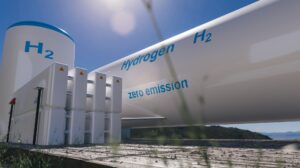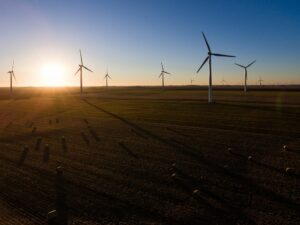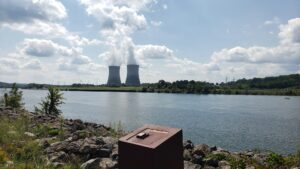Alberta 
Alberta waste to energy facility gets green light
Gibson Energy Inc., and Varme Energy Inc. have entered into a strategic partnership to accelerate the development of Canada’s first waste-to-energy facility with carbon capture technology. If successful, the project will be located on Gibson land in Alberta’s Heartland-area and will have the capability to process 200,000 tonnes per annum of municipal solid waste, diverting residential garbage from landfill. This proposed greenfield waste-to-energy facility, which would be constructed by the Partnership and operated by Gibson, would have integrated carbon capture equipment enabling the Project to incinerate municipal solid waste and produce carbon-negative electricity. The project supports the advancement of technologies fundamental to achieving a net-zero electricity grid across the country. By accelerating local waste diversion, the project will increase the supply of carbon negative electricity in Alberta by avoiding harmful methane emissions. Governments globally, including the Government of Canada and the Government of Alberta, have identified rapid reductions in methane emissions as key to limiting near-term climate impacts. Source: Environment Journal
Electricity Prices for Alberta
The Alberta power pool price averaged 4.809 cents per kWh in June 2024. This price is 1.272 cents higher than last month’s average of 3.537 cents. The pool price has averaged 9.562 cents per kWh over the last 12 months.
As of June 25, 2024, the forward market was predicting electricity prices for the calendar years of 2024, 2025, 2026, 2027, 2028, and 2029. These prices are 6.032, 5.156, 5.176, 5.525, 6.225, and 6.350 cents per kWh respectively.
Gas Prices for Alberta
Direct Energy’s gas rate for June 2024 was $1.050 per GJ in Alberta. The July 2024 rate has been set at $0.698 per GJ. Alberta gas prices have averaged $2.360 per GJ over the last 12 months.
As of June 26, 2024, the forward market was predicting gas prices for the calendar years of 2024, 2025, 2026, 2027, and 2028. These prices are 1.45, 2.81, 3.21, 3.25, and 3.28 cents per GJ respectively.
British Columbia 
New UBC research facility accelerates innovation in B.C.’s hydrogen energy sector
 B.C.’s hydrogen infrastructure enters a new era with the launching of the $23-million Smart Hydrogen Energy District (SHED) at UBC. Equipped with a hydrogen fueling station, this facility is expected to pave the way for breakthroughs in critical energy research. SHED will produce hydrogen using solar and hydro power to operate a water electrolyser, making the process completely green and renewable. It is one of the first initiatives in Canada to combine hydro, solar and hydrogen energy at a single site, connecting these renewable energy sources to a unified micro-grid. SHED will be the province’s first hydrogen station to serve light- and heavy-duty vehicles. SHED combines various technologies within a city block, serving as a model for compact urban planning. A rooftop solar array powers both the hydrogen fueling station and nearby electric vehicle charging stations. Two-way charging will enable parked EVs to both draw power from the grid and give excess stored electricity back to the grid during peak hours when there is extra energy demand. The global hydrogen market is expected to grow significantly in the coming decades, and Canada will need sustained research to maintain and expand its leadership in hydrogen technologies. Source: UBC News
B.C.’s hydrogen infrastructure enters a new era with the launching of the $23-million Smart Hydrogen Energy District (SHED) at UBC. Equipped with a hydrogen fueling station, this facility is expected to pave the way for breakthroughs in critical energy research. SHED will produce hydrogen using solar and hydro power to operate a water electrolyser, making the process completely green and renewable. It is one of the first initiatives in Canada to combine hydro, solar and hydrogen energy at a single site, connecting these renewable energy sources to a unified micro-grid. SHED will be the province’s first hydrogen station to serve light- and heavy-duty vehicles. SHED combines various technologies within a city block, serving as a model for compact urban planning. A rooftop solar array powers both the hydrogen fueling station and nearby electric vehicle charging stations. Two-way charging will enable parked EVs to both draw power from the grid and give excess stored electricity back to the grid during peak hours when there is extra energy demand. The global hydrogen market is expected to grow significantly in the coming decades, and Canada will need sustained research to maintain and expand its leadership in hydrogen technologies. Source: UBC News
Ontario 
Enbridge Gas Is ‘Fighting For Its Survival’—That Means Keeping Ontario on Fossil Fuels
For more than 70 years, the $50-billion Calgary-based private company has held a monopoly on natural gas distribution in Ontario. Enbridge delivers the methane-heavy fuel—one of Ontario’s cheapest and last remaining fossil fuel-based sources of energy—through its network of pipelines that crisscross the province, heating three-quarters of homes. But the onset of the climate emergency—and the need to move away from fossil fuels—has posed an existential threat to Enbridge, the likes of which it has never experienced. Just as mobile phones replaced the landline, cheap energy from wind, water, and sun threaten to replace natural gas and other fossil fuels that create greenhouse gas emissions and exacerbate global heating.
Enbridge has long tried to influence towns and cities to stay on or expand their use of natural gas, but its latest efforts seem like a full-scale defense of a fossil-dependent business model, even as both sentiments and technologies shift elsewhere. In Ontario, all energy companies are obligated to work with both municipalities and the Ontario Energy Board to deliver electricity and heat to residents. Enbridge has to secure agreements with a city or town before building new natural gas infrastructure. One way Enbridge secures these agreements is by sending a specialized team to municipalities, they fall under Enbridge’s conservation department, but its job is to ensure the expansion of natural gas. Source: The Local
Saskatchewan 
Province provides Indigenous consortium with $100M in loan guarantees for wind farm project
 A consortium of five Saskatchewan First Nations, Metis Nation-Saskatchewan along with a North American energy infrastructure company are advancing plans to build a 200-megawatt wind farm with the help from of $100 million in loan guarantees from a provincial government corporation. This will help Six Nations Energy Development LP – a newly formed consortium comprising Cowessess, George Gordon, Kahkewistahaw, Pasqua and White Bear First Nations as well as Métis Nation-Saskatchewan – get at least a 30 per cent ownership stake in the Seven Stars Energy Project. Dustin Duncan, the minister responsible for SaskPower, says the project is expected to generate enough emissions–free power to support the annual energy needs of more than 100,000 Saskatchewan homes. The project will help ensure SaskPower reaches its goals of achieving net-zero greenhouse gas emissions by 2050 and deploying up to 3,000 MW of wind and solar generation by 2035. Source: CBC
A consortium of five Saskatchewan First Nations, Metis Nation-Saskatchewan along with a North American energy infrastructure company are advancing plans to build a 200-megawatt wind farm with the help from of $100 million in loan guarantees from a provincial government corporation. This will help Six Nations Energy Development LP – a newly formed consortium comprising Cowessess, George Gordon, Kahkewistahaw, Pasqua and White Bear First Nations as well as Métis Nation-Saskatchewan – get at least a 30 per cent ownership stake in the Seven Stars Energy Project. Dustin Duncan, the minister responsible for SaskPower, says the project is expected to generate enough emissions–free power to support the annual energy needs of more than 100,000 Saskatchewan homes. The project will help ensure SaskPower reaches its goals of achieving net-zero greenhouse gas emissions by 2050 and deploying up to 3,000 MW of wind and solar generation by 2035. Source: CBC
Manitoba 
Going Green: Manitoba’s Clean Energy Future
More than 95 per cent of the electricity generated in Manitoba comes from a renewable source: hydro, making the province a leader in clean energy development. However, Manitoba still imports 70 per cent of its energy for transportation and heating in the form of fossil fuels. In accordance with national greenhouse gas emissions reduction targets, Manitoba is moving towards a cleaner energy future with ambitious goals of having a net-zero power grid by 2035 and being carbon neutral by 2050. Manitoba has unique advantages for harnessing green energy, including freshwater resources that support hydro and hydrogen production, along with conditions that support the incorporation of wind turbines and solar panels.
In addition, the province has biomass feedstocks (crops that can be used as fuel or converted into other forms of energy) and critical minerals essential for developing clean technologies, energy storage systems and electric vehicles. Trending technologies in the clean energy space include ground and air source heat pumps, geothermal heating, the use of hydrogen in transportation, and carbon capture and storage. Through collaboration and consultation with governments, NGOs, businesses and Indigenous groups, the clean energy transition in Manitoba is set to position the province as a prosperous leader driving change. Source: Manitoba Chambers of Commerce
New Brunswick 
Time for N.B. Power to shop around for nuclear options, ex-CEO says
 A former CEO of Arc Clean Energy Canada says it’s time N.B. Power looks at other options for small modular nuclear reactors beyond two companies looking to build them in New Brunswick. N.B. Power should consider shopping around to get more nuclear generation on the provincial grid by 2030 or 2035. Last year a legislative committee was told that ARC’s 100-megawatt small modular nuclear reactor would be ready by 2030. But at Energy and Utility Board hearings this week, the Crown corporation’s vice-president of business development and strategic partnerships, Brad Coady, said SMRs “probably won’t be ready by 2030.”
A former CEO of Arc Clean Energy Canada says it’s time N.B. Power looks at other options for small modular nuclear reactors beyond two companies looking to build them in New Brunswick. N.B. Power should consider shopping around to get more nuclear generation on the provincial grid by 2030 or 2035. Last year a legislative committee was told that ARC’s 100-megawatt small modular nuclear reactor would be ready by 2030. But at Energy and Utility Board hearings this week, the Crown corporation’s vice-president of business development and strategic partnerships, Brad Coady, said SMRs “probably won’t be ready by 2030.”
The provincial government gave ARC $20 million in 2021 to help it develop its reactor, and the previous Liberal government gave it $10 million. The province has pitched ARC and another company in Saint John, Moltex Energy, as key to the transition to non-fossil-fuel emitting electricity generation by 2035, the deadline established under the federal government’s climate action plan. The government and N.B. Power are also racing to find replacement electricity for the Belledune generating station, which must stop burning coal by 2030. The first priority must be to get more generation in place, and it may make sense to look at companies further along and better able to build more units sooner. Source: CBC
Prince Edward Island 
Province encouraging Islanders to try out an EV this summer
 The province is once again partnering with Safe Drivers PEI on the EV Experience Tour. At these events, Islanders have the opportunity to get behind the wheel of an electric vehicle. Representatives from the Office of Net Zero will be on location during the EV Experience Tour to answer any EV-related questions, as well as to share information about government rebates and incentives on electric vehicles. Islanders who buy a new, fully electric vehicle may be eligible for up to $10,750 off the purchase price with the federal government incentive of $5,000 and the PEI Universal EV and Charging Incentive of $5,750. Government will offer $3,250 off a plug-in hybrid electric vehicle. Rebates are also available on used EVs. Source: Prince Edward Island
The province is once again partnering with Safe Drivers PEI on the EV Experience Tour. At these events, Islanders have the opportunity to get behind the wheel of an electric vehicle. Representatives from the Office of Net Zero will be on location during the EV Experience Tour to answer any EV-related questions, as well as to share information about government rebates and incentives on electric vehicles. Islanders who buy a new, fully electric vehicle may be eligible for up to $10,750 off the purchase price with the federal government incentive of $5,000 and the PEI Universal EV and Charging Incentive of $5,750. Government will offer $3,250 off a plug-in hybrid electric vehicle. Rebates are also available on used EVs. Source: Prince Edward Island
Québec 
New bill aims to change how and when Quebecers consume energy
Quebec Economy Minister Pierre Fitzgibbon wants Quebec to become carbon-neutral by 2050 and that means making some changes to the way people consume electricity. To reach its climate targets, the province says it needs to make double the energy it’s currently producing. Renewable energy projects such as wind and solar will have to multiply. To accelerate those projects, Quebec wants to reduce bureaucracy. Another disposition is to allow companies to produce their own energy and sell the surplus to neighbours, something manufacturers celebrate as they seek to grow their businesses. A recent survey conducted by Quebec Manufacturers and Exporters shows that about a third of its members say they don’t have enough access to renewable energy to be able to either achieve their investment projects or decarbonize their operations. But critics say too many details are missing in the bill in order to actually meet the province’s goal of carbon neutrality by 2050. Source: Global News
Newfoundland and Labrador 
Interest in NL’s Green Transition Fund results in second EOI
There has been significant interest shown for the Newfoundland and Labrador Government’s Green Transition Fund. This has resulted in the launch of the second call for expressions of interest for the fund, as well as details of a number of approved projects. To date, throughout the province there have been 11 projects approved and 18 are currently under assessment by the department. For the 29 proposals received, the total project value was $28.2 million with a Green Transition Fund request totaling $9.8 million. The Green Transition Fund aims to propel forward the development of renewable energy and clean technologies in the province and position Newfoundland and Labrador as a leader in the global green transition. This fund supports the greening of commercial operations, research and development, manufacturing and extractive resource development, and other areas that help transition to a greener economy. Source: Environment Journal
Nova Scotia 
Regulator OKs Nova Scotia Power’s $354M battery project
Nova Scotia Power is gearing up to build battery systems at three sites to help bring energy stability to the grid as the province moves to replace fossil fuels with renewable energy sources. The utility expects the project to cost about $354 million, with about $116 million covered by a federal grant and the remaining $237 million footed by ratepayers. The utility expects the project to cost about $354 million, with about $116 million covered by a federal grant and the remaining $237 million footed by ratepayers. Nova Scotia Power said utility-scale battery storage “is poised to play a key role in Nova Scotia’s energy transition.”
It said that as more renewable energy is added to the grid, batteries will provide stability by storing energy when the wind is blowing or the sun is shining, and then dispatching that energy at times of peak demand. In the first quarter of this year, Nova Scotia Power got 43 per cent of its electricity from renewable sources, primarily hydro electricity brought in from Newfoundland and Labrador’s Muskrat Falls through the Maritime Link, and wind energy from local turbines. The remaining 57 per cent of Nova Scotia’s electricity comes from fossil fuels, predominantly coal. Nova Scotia Power is obligated, through provincial legislation, to get off coal and reach 80 per cent renewable energy by 2030. Source: CBC
Nunavut 
Cold-Climate Wind Turbines Show Potential to Replace Diesel
 Wind turbines popping up in communities in Nunavut are helping to establish the technology’s potential in cold climates, where high wind speeds offer an ideal resource to replace fossil fuels. Arctic-specific research on wind turbines could greatly inform remote Northern communities’ energy strategies. As in other places across the world’s Arctic regions, all 25 generating stations that power Nunavut communities rely on imported diesel fuel, and 55 million litres of diesel were purchased for those stations in 2018 alone. Cambridge Bay has access to a lot of wind energy if it can harness it – the average wind speed in Cambridge Bay clocks in at 19.4 km/h. Given the cost and environmental impact of diesel imports, the region’s high wind speeds are a tempting source of clean energy that communities can harness for themselves with the right technology.
Wind turbines popping up in communities in Nunavut are helping to establish the technology’s potential in cold climates, where high wind speeds offer an ideal resource to replace fossil fuels. Arctic-specific research on wind turbines could greatly inform remote Northern communities’ energy strategies. As in other places across the world’s Arctic regions, all 25 generating stations that power Nunavut communities rely on imported diesel fuel, and 55 million litres of diesel were purchased for those stations in 2018 alone. Cambridge Bay has access to a lot of wind energy if it can harness it – the average wind speed in Cambridge Bay clocks in at 19.4 km/h. Given the cost and environmental impact of diesel imports, the region’s high wind speeds are a tempting source of clean energy that communities can harness for themselves with the right technology.
Source: The Energy Mix
Northwest Territories 
Could renewable diesel power NWT’s green ideals?
Renewable diesel and biodiesel (or green diesel) are not the same type of fuel. Renewable diesel is a fuel made from fats and oils and is processed to be chemically the same as petroleum diesel. Renewable diesel performs as well as fossil diesel but is made from renewable raw materials reducing greenhouse gas emissions by as much as 75 to 95 per cent compared to fossil diesel, claims a Finnish manufacturer. Renewable diesel can work well in very cold weather, but a special arctic grade is required, which is extremely expensive to purchase small quantities to test here. So far seven new renewable diesel facilities are planned, or under construction, in Alberta, British Columbia, Quebec, and Newfoundland and Labrador. Source: CKLB Radio-The Voice of Denendeh
Yukon 
In the Arctic, a massive new Inuvialuit-led conservation area protects Porcupine caribou grounds
A great expanse of tundra in the northeast corner of the Yukon is now protected by an Indigenous-led conservation area, safeguarding important Inuvialuit harvesting areas for future generations. Aullaviat/Anguniarvik (pronounced Au-la-vat/Angu-niag-a-vik), Traditional Conservation Area covers almost 850,000 hectares of land nestled between the Beaufort Sea to the north, Ivvavik and Vuntut national parks to the west and the Northwest Territories to the east. With the establishment of this new conservation area, a decades-old vision to protect the northern stretch of the Yukon used by the Porcupine caribou herd comes to fruition.
The new conservation area is also significant as Canada strives to meet its international commitments to protect 30 per cent of land and waters by 2030, as part of global efforts to stem nature losses. The Yukon is leading conservation efforts among provinces and territories, having protected 21.1 per cent of land, including Aullaviat/Anguniarvik which covers 1.8 per cent of the territory. “Indigenous-led conservation is one of the most important pathways for achieving Canada’s biodiversity goals and sustaining long-term conservation gains,” federal Environment and Climate Change Minister Steven Guilbeault said. Source: The Narwhal